Laws of BUGHOUSE chess
(OTB = Over The Board)
Document Version 1.01
In accordance with WBN rules - ratified by WBN.
In these Laws the words 'he', 'him' and 'his' include 'she' and 'her' and 'it' and 'its'.
RULES OF GAME
Bughouse is a realtime form of chess played between two player teams on two separate chessboards. Both boards are placed near to each other and the clocks on the side, so that each player can see the time on both clocks.
The special feature of the game is that pieces you capture are transferred to your partner, who is playing with the opposite colour pieces from yourself. He may 'drop' such a piece on an empty square as a subsequent move in his game.
The game is typically played at a very fast time control (such as 1-3 minute games; with 2-3 sec for move bronstein system). Time is kept track of using two clocks (typically digital), one clocks for each chessboard. The game is not touch move but "clock move", that is, the move is not considered to be made until the player hits his clock. The pawn is on last rank promoted to Queen or Knight, but its only temporary until is removed from board. A player may not hide captured pieces from your opponent. Full communication between partners is allowed.
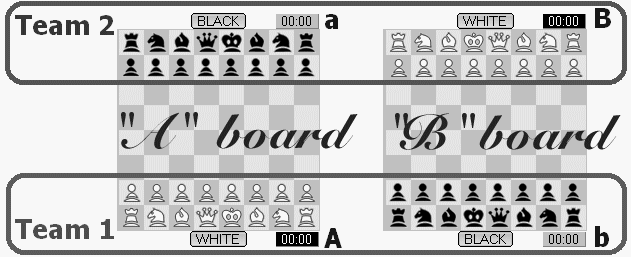
Before the game the players and arbiter should agree on the position of the stuff-place, for example:
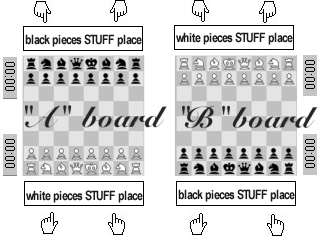
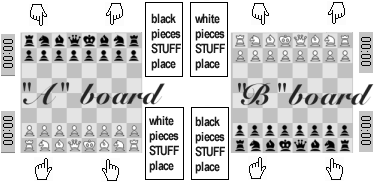
- If a player hides pieces in an improper way (rule 1.7), his opponent (or partner of his opponent) is entitled to warn him to "show pieces".
- If a player drops a hidden piece, his opponent may restrict its use by the message "invisible", e.g. "invisible bishop". The opponent may then immediately start the player's clock and force him to make another move.
- A piece restricted in this way may not be used until the opponent allows (by the message "bishop visible now", for example). The opponent should allow it as soon as possible, in good sportsmanship.
- If a player repeatedly hides his pieces, his opponent (or partner of his opponent) may claim "repeatedly hiding" and the arbiter may impose some sanction. (rule 9.4.)
- If a piece is hidden through no fault of the player, and this drastically alters the game, the arbiter may order a new game.
- It is illegal for a player to move one of his partner's pieces or in any way physically intervene on his partner's board. For example, he may not advise moves to his partner by moving his finger over his partner's board.
- Partners may verbally communicate throughout a game. Full communication between partners is allowed. So the player can advise to partner even concrete moves.
- A team is awarded one point (1) for winning the bughouse game, or winning by default.
- A team is awarded no points (0) for losing the bughouse game, or forfeiting.
- A team is awarded a half point (1/2) for drawing the bughouse game.
- The game is won by the player who has checkmated his opponent's king. This immediately ends the game, provided that the move producing the checkmate position was a legal move.
- The game is won by the player whose opponent made illegal move. This immediately ends the game.
- The game is won by the player whose opponent declares he resigns. This immediately ends the game.
- The game is draw upon agreement between the two players during the game. This immediately ends the game.
- The game is draw if any identical position is about to appear or has appeared on the chessboard at least three times.
- The bughouse game is draw when player is taking a piece, then (in the next opponent move) is checkmated, his partner's move is in this moment, his partner is by dropping this piece (before his time is out) checkmating opponent or making draw by achievement of 3x repeated position (See 2.2.b).
- A player wishing to offer a draw shall do so after having made a move on the chessboard and before stopping his clock and starting the opponent's clock. An offer at any other time during play is still valid, but Article 8.4 must be considered. No conditions can be attached to the offer. In both cases the offer cannot be withdrawn and remains valid until the opponent ends his move.
- A claim of a draw shall be considered to be an offer of a draw.
If the claim is found to be correct the game is immediately drawn. If the claim is found to be incorrect, the stopping of clocks is considered as illegal move.
The chessboard is placed between the players in such a way that the near corner square to the right of the player is white.
At the beginning of the game one player has 16
light-coloured pieces (the 'white' pieces); the other has 16
dark-coloured pieces (the 'black' pieces): These pieces are as
follows:
| A white king, usually indicated by the symbol |  |
| A white queen, usually indicated by the symbol |  |
| Two white rooks, usually indicated by the symbol |  |
| Two white bishops, usually indicated by the symbol |  |
| Two white knights, usually indicated by the symbol |  |
| Eight white pawns, usually indicated by the symbol |  |
| A black king, usually indicated by the symbol |  |
| A black queen, usually indicated by the symbol |  |
| Two black rooks, usually indicated by the symbol |  |
| Two black bishops, usually indicated by the symbol |  |
| Two black knights, usually indicated by the symbol |  |
| Eight black pawns, usually indicated by the symbol |  |
The standard initial position of the pieces on the chessboard is as follows:

The eight vertical columns of squares are called 'files'. The eight horizontal rows of squares are called 'ranks'. A straight line of squares of the same colour, touching corner to corner, is called a 'diagonal'.
It is not permitted to move a piece to a square occupied by a piece of the same colour. If a piece moves to a square occupied by an opponent's piece the latter is captured and removed from the chessboard as part of the same move. A piece is said to attack an opponent's piece if the piece could make a capture on that square according to Articles 5.2 to 5.8.
The bishop may move to any square along a diagonal on which it stands.

The rook may move to any square along the file or the rank on which it stands.
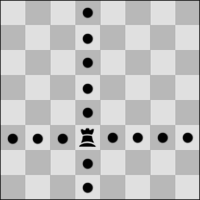
The queen may move to any square along the file, the rank or a diagonal on which it stands.
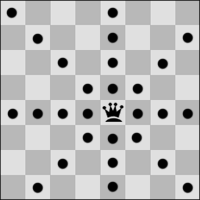
When making these moves the bishop, rook or queen may not move over any intervening pieces.
The knight may move to one of the squares nearest to that on which it stands but not on the same rank, file or diagonal.
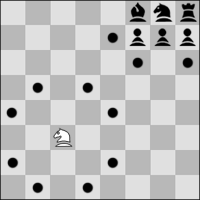
- The pawn may move forward to the unoccupied square immediately in front of it on the same file
- or from second rank the pawn may move as in (a); alternatively it may advance two squares along the same file provided both squares are unoccupied
-
or the pawn may move to a square occupied by an
opponent's piece, which is diagonally in front of it on an
adjacent file, capturing that piece.
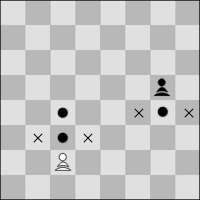
-
A pawn attacking a square crossed by an opponent's pawn which has advanced two squares in one move may capture this opponent's pawn as though the latter had been moved only one square.
This capture may only be made on the move following this advance and is called an 'en passant' capture.

-
moving to any adjoining square not attacked by
one or more of the opponent's pieces.
The opponent's pieces are considered to attack a square, even if such pieces cannot themselves move.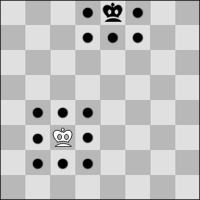
-
'castling'. This is a move of the king and either
rook of the same colour on the same rank, counting as a single
move of the king and executed as follows: the king and the rook are transferred
from their original squares (squares where they stood in initial position),
the king is transferred two squares towards the rook, then that
rook is transferred to the square the king has just crossed.
(1) Castling is illegal: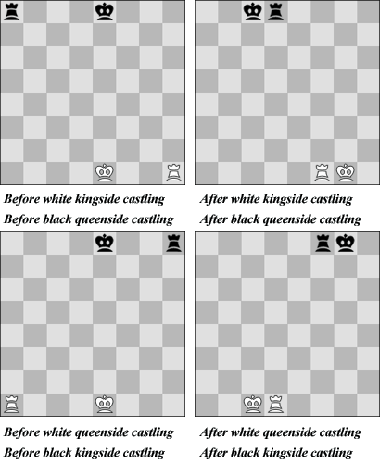
- if the king has already moved, or
- with a rook that has already moved, or
- with dropped rook.
- if the square on which the king stands, or the square which it must cross, or the square which it is to occupy, is attacked by one or more of the opponent's pieces.
- if there is any piece between the king and the rook with which castling is to be effected.

Each move must be made with one hand only. Each move must be made with one hand only. Although a player may use both hands as long as he moves the piece to its destination square with the same hand he uses to start his opponent's clock. This means that a player can capture a piece using this method: with the left hand he removes the piece from the board and then with the right hand moves his piece and with right hand starts his opponent's clock. He may then use either hand to transfer the captured piece to his partner's stuff place. Also a player may use both hands to castle, although no hand can start opponent's clocks until castling is complete.
Provided that he first expresses his intention (e.g. by saying "j'adoube" or "I adjust"), the player may adjust one or more pieces on their squares.
If a player displaces one or more pieces, he shall re-establish the correct position on his own time. If it is necessary, his opponent may start the player's clock without making a move in order to make sure that the player uses his own time while replacing the pieces. The arbiter may penalise the player who displaced the pieces.
- "Non-disruptive premove" is allowed: After player made his move (made move = when player moved piece to destination square and leave hold of it) his opponent is allowed to start making of his next move, but opponent cannot completed his move (completed move = when move is made and player started opponents clock) before player completed his move first (if both player and his opponent made move, opponent has to wait until player started his clock and only after this can start the clock also, no blocking of clock or "move per zero time" is allowed, the player has right to start opponent's clock). Is allowed to player after making move to change his opinion and return it back and making another move, although it could be not very often, best way how it could be doing is such a way that move is not made (i.e. player dont leave hold of piece). The time between making and completing the move should be as short as possible. If opponent made his next move before player made move, it is called "premove" and it can be claimed by player and sanction (see 9.4) can be applied to (it is recomended to apply freezing sanction for a few seconds). If player made move, but didn't completed it and after this wish to make another move, his opponent should return back his next move.
- It is bad sportsmanship to "hawk" with a hand over the board.
'Clocks' means a clock with two time displays,
connected to each other in such a way that only one of them can run
at one time.
'Clock' in these Laws means one of the two time displays.
'Flag fall' means the expiration of the allotted
time for a player.
Each time display has a 'flag' (or some digital equivalent like "0:00"). Immediately after the flag falls, the end of the game can be claimed.
Digital clocks should be used if available. If possible, the same model of clock shoudl be used on each board. Before the start of the game the arbiter should check that the clocks are satisfactory.
At the time determined for the start of the game the clocks of the players who have the white pieces are started.
If neither player is present initially, the player who has the white pieces shall lose all the time that elapses until he arrives; unless the rules of the competition specify or the arbiter decides otherwise.
-
During the game each player, having made his move
on the chessboard, shall stop his own clock and start his
opponent's clock. A player must always be allowed to stop his
clock. His move is not considered to have been completed until he
has done so, unless the move that was made ends the game.
The time between making the move on the chessboard and stopping his own clock and starting his opponent's clock is regarded as part of the time allotted to the player. - A player must stop his clock with the same hand as that with which he made his move. It is forbidden for a player to keep his finger on the button or to 'hover' over it.
- The players must handle the clocks properly. It is forbidden to punch it forcibly, to pick it up or to knock it over. Improper clock handling shall be penalised in accordance with Article 9.4.
- If a player is unable to use the clock or physically manipulate with pieces, an assistant, who is acceptable to the arbiter, may be provided by the player to perform this operation.
A flag is considered to have fallen when either player or his partner has made a valid claim to that effect.
Except where Articles 2.1 or 2.2 apply, if a player does not complete the game in the allotted time, the game is lost by the player.
Except where Articles 2.1 or 2.2 apply, if both flags have fallen the game is drawn.
Every indication given by the clocks is considered to be conclusive in the absence of any evident defect. A clocks with an evident defect shall be replaced. The arbiter must order a new bughouse game.
- If the game needs to be interrupted, the arbiter shall stop both clocks.
- A player may stop both clocks only in order to seek the arbiter's assistance.
- The arbiter shall decide when the game is to be restarted in either case.
- If a player stops the clocks in order to seek the arbiter's assistance, the arbiter shall determine if the player had any valid reason for doing so. If it is obvious that the player has no valid reason for stopping the clocks, the stopping of clocks is considered as illegal move.
The players shall take no action that will bring the game of bughouse into disrepute.
Infraction of any part of the Articles 8.1 to 8.4 shall lead to penalties in accordance with Article 9.4.
Persistent refusal by a player to comply with the this Laws shall be penalised by loss of the game. The arbiter shall decide the score of the opponent.
If both players are found guilty according to Article 8.6, the game shall be declared lost by both players.
- warning,
- order "freezing" of player for 5 (or 10) sec (= player has to wait until time on his clock will be 5 second less than in the moment in which was freezed and only in this moment can continue in game),
- declaring the game to be lost,
- order a new game,
- reducing the points scored in a game by the offending party,
- increasing the points scored in a game by the opponent to the maximum available for that game,
- expulsion from the event.
That means the arbiter should also be silent about illegal moves, flag falls, etc. (unless there is an agreement with all the players, before the game, to call them) as this is entirely the responsibility of the players.
Algebraic notation

In the case of pawns, only the square of arrival is indicated. Examples: e5, d4, a5.
When a pawn makes a capture, the file of departure must be indicated, then an x, then the square of arrival.. Examples: dxe5, gxf3, axb5. In the case of an "en passant" capture, the square of arrival is given as the square on which the capturing pawn finally rests.
- By (a) the first letter of the name of the piece, (b) the square of departure, and (c) the square of arrival.
- If only one piece of the same kind which is able to move to arrival square is on the file : by (a) the first letter of the name of the piece, (b) the file of the square of departure, and (c) the square of arrival.
- If only one piece of the same kind which is able to move to arrival square is on the rank : by (a) the first letter of the name of the piece, (b) the rank of the square of departure, and (c) the square of arrival.
There are two knights, on the squares g1 and e1, and one of them moves to the square f3: either Ngf3 or Nef3, as the case may be.
There are two knights, on the squares g5 and g1, and one of them moves to the square f3: either N5f3 or N1f3, as the case may be.
There are two knights, on the squares h2 and d4, and one of them moves to the square f3: either Nhf3 or Ndf3, as the case may be.
If a capture takes place on the square f3, the previous examples are changed by the insertion of an x: (1) either Ngxf3 or Nexf3, (2) either N5xf3 or N1xf3, (3) either Nhxf3 or Ndxf3, as the case may be.
There are three knights, on the squares g1,e1,g5 and one of them moves to the square f3: either Ng1f3 or Nef3 or N5f3.
Essential abbreviations:
| O-O | castling with rook h1 or rook h8 (kingside castling) |
| O-O-O | castling with rook a1 or rook a8 (queenside castling) |
| x | captures |
| + | check |
| ++ or # | checkmate |
Description of any bughouse game.
[Event "Sample bughouse game"][Site "Nowhere"]
[Date "2002.01.01"]
[WhiteA "WhiteA"][WhiteAElo "----"]
[BlackA "BlackA"][BlackAElo "----"]
[WhiteB "WhiteB"][WhiteBElo "----"]
[BlackB "BlackB"][BlackBElo "----"]
[TimeControl "300+0"]
[Result "1-0"]
1A. e4 {299} 1B. e4 {299} 1a. e6 {299} 1b. e5 {299} 2A. d4 {298} 2a. d5 {298} 2B. Bc4 {297} 2b. Nf6 {298} 3A. c4 {297} 3a. dxe4 {294} 4A. d5 {296} 4a. exd5 {290} 5A. cxd5 {295} 3B. Nc3 {287} 3b. Bb4 {297} 4B. Bxf7+ {286} 4b. Kxf7 {296} 5B. Nh3 {285} 5b. Bxc3 {295} 5a. Nf6 {284} 6B. dxc3 {284} 6A. Bc4 {294} 6a. Bg4 {283} 6b. d5 {293} 7B. Ng5+ {283} 7b. Ke7 {292} 8B. exd5 {282} 8b. Qxd5 {291} 7A. P@e6 {284} 7a. Bxd1 {282} 9B. P@d4 {275} 9b. exd4 {290} 8A. exf7+ {282} 10B. Qe2+ {274} 8a. Kxf7 {281} 9A. N@e5+ {281} 9a. Ke8 {280} 10b. P@e3 {283} 11B. Bxe3 {273} 10A. B@f7+ {276} 10a. Ke7 {279} 11b. Qxg5 {278} 11A. N@f5# {272}
{*} 1-0
Description of any bughouse position.
BFEN example:
r2k1r2/pbppNppp/1p2p1nb/1P5N/3N4/4Pn1q/PPP1QP1P/2KR2R1/BrpBBqppN - - w 45 56 | Q~4rk1/8/8/8/8/8/8/R3K2R KQ - w 45 60
BFEN Corresponding position:

As you see in the example, bfen has the following structure: board A bfen, followed by separator '|' followed by board B bfen.
Board A bfen has the following structure: Standard FEN for position (r2k1r2/pbppNppp/1p2p1nb/1P5N/3N4/4Pn1q/PPP1QP1P/2KR2R1) with one modification: ~ after piece denotes promoted piece (on board B white queen on a8 is a promoted one) slash(/), holdings (BrpBBqppN; pieces in uppercase belong to white, pieces in lowercase belong to black; in the example white holds 3 bishops and a knight, black holds rook, queen and 3 pawns), space, side to move ( w if white's move, b if black's move), space, castling possibilities(Dash denotes that nobody can castle, K=white can castle kingside,k=black can castle kingside, Q=white can castle queenside, q=black can castle queenside. On board A we have we have dash in the BFEN, so nobody can castle. On board B we have KQ in the bfen, ergo white can castle both kingside and queenside, while black cannot castle at all), space,enpassant posibilities(Dash=no enpassant possible, otherwise enpassant square,i.e e3 or d6, etc. In our example there are no enpassant possibilities) space, white's time in seconds(45), space, black's time in seconds (56). Board B bfen has similar structure. You may notice that pieces in hand are absent, so holdings and slash before holdings are omited.
Fen consists of 8 parts separated by slash (r2k1r2/pbppNppp/1p2p1nb/1P5N/3N4/4Pn1q/PPP1QP1P/2KR2R1). Each part represents a rank on the chessboard. The first part(r2k1r2) represents 8th rank and the last part (2KR2R1) represents 1st rank. Numbers in fen stand for empty squares, letters in lowercase stand for black pieces and letters in uppercase stand for white pieces. For example, r2k1r2 means black rook (on a-file) followed by 2 empty squares (on files "b" and "c") , followed by black king (on d-file), followed by an empty square (on e-file) followed by black rook (on f-file), followed by 2 empty squares (on g- and h-files).